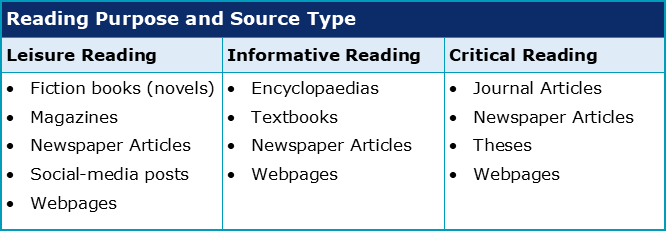Why is reading speed important at university?

This is the first of three chapters about Improving Reading Speed. To complete this reader, read each chapter carefully and then unlock and complete our materials to check your understanding.
– Introduce and importance of reading speed
– Discuss the three general purposes for reading in relation to skimming, scanning and reading intensively
– Explore the four primary reasons for academics wishing to improve their reading speed
Before you begin reading...
-
video and audio texts
-
knowledge checks and quizzes
-
skills practices, tasks and assignments
Chapter 1
When it comes to reading skills, there are a number of reading strategies that academic students must become quickly familiar with. None, however, is generally more important to non-native speakers of English than the quick and certain methods that might be used to improve reading speed. While in truth there is no tried and tested scientific formula for improving a person’s speed and maintaining comprehension, there are a number of strategies that students can follow if they wish to improve the rate at which they can understand written information.
This short three-chapter reader focuses specifically on how to improve reading speed and reading accuracy. This first chapter explores the different types of reading that learners of academic English will likely be faced with, listing the reasons for needing to increase speed and outlining twelve techniques for doing so. Chapter 2 then explores these twelve tips in much more detail, providing examples wherever possible to help guide the reader. Finally, while Chapter 3 recommends some external websites for accurately testing reading speed, Academic Marker also provides a short reading text so that students can confidently test speed and comprehension.
What will you read at university?
During your time completing a bachelor’s or master’s degree, and during any person’s life in general, you’re going to need to read a variety of different source types. Whether you’re reading a Tolkien novel, are flicking through the newspaper or are focusing carefully on the information contained within an academic journal article, people read different source types for slightly different purposes and in slightly different ways. You may wish to read a novel more slowly, stopping to imagine the situation or think more deeply about the ideas, or you might wish to read a textbook more quickly, taking in as much information as you can in a short space of time.

Generally speaking, there are three reasons in which a reader might read. These three purposes are (1) reading for leisure, (2) reading for information, and (3) reading critically. Arranged into these three categories, the following table presents some of the most common source types that university students are likely to read:

How will you read at university?
How students read these various sources will vary not only depending on the type of source they read and their purpose for reading, but also precisely on how they read that information. As our short reader on reading strategies explains in much more detail, skimming, scanning and intensive reading are three commonly accepted reading techniques that students tend to follow when they interpret texts – sometimes without even realising. These three strategies are explored briefly below:
- Skim Reading: This is when a reader gets an overall impression of the text by looking at any images, by quickly reading any headings and subheadings and by potentially also skimming the introduction and conclusion for key information.
- Scan Reading: This type of reading is more commonly used to find specific pieces of information within a text, such as statistics, dates or names and examples. Like skimming, when scanning, the reader doesn’t read every word and instead only reads the necessary information.
- Reading Intensively: Finally, intensive reading is when the reader follows a text very carefully, perhaps looking for the deeper meaning within that text such as by determining what the author really thinks about the subject.
While these three techniques may be used on any source type at any time, generally the purpose for reading and the type of source being read tend to interact. When reading a newspaper for pleasure, for example, you might skim the contents of that paper looking for something that interests you. When reading informatively, you might instead scan the newspaper’s tabloids and specific articles looking for the results of a football game or the latest election results, for example. Likewise, if you consider using a newspaper in your academic research, you may then read that paper intensively and critically to determine appropriacy, subtext or levels of bias.
Why is reading speed important?
For the general public, reading speed isn’t necessarily an important skill. Everyone reads at their own pace, and unless you’re competing with a friend for how many novels you can read in a month perhaps, it’s likely that you’ll care little for how long it takes you to finish a particular book provided you enjoy reading it. For university students, however, reading speed is a more critical skill that must be practised to achieve academic success. There are, in fact, four key reasons that students of academic English may wish to improve their reading speed:
- Conducting Research Skills: Students will be required to read vast amounts of text during their degree – usually to challenging deadlines. The quicker that textbooks and journal articles can be processed, the more research can be done by a student in the time allowed.
- Succeeding in Lectures/Seminars: It might be the writing on a PowerPoint presentation or the text on a handout, but students will have to keep up with their seminar and lecture material so that they can contribute effectively to classroom tasks and discussions.
- Passing Examinations: Timed writings in particular will usually provide students with both an input text or two and a short amount of time to construct an answer to a question. If a student cannot read the text quickly enough, they will probably not have sufficient time to write a successful and comprehensive answer.
- Passing Proficiency Tests: Finally, English proficiency tests such as IELTS and TOEFL usually have some kind of reading activity, often with a large word count for the time allocated. If a student wishes to score highly on these tests, they’ll need to read quickly and under pressure.
What are the top tips for improving reading speed?
To find out which strategies for improving reading speed we recommend here at Academic Marker, continue reading on to Chapter 2.
Downloadables
Once you’ve completed all three chapters about improving reading speed, you might also wish to download our beginner, intermediate and advanced worksheets to test your progress or print for your students. These professional PDF worksheets can be easily accessed for only a few Academic Marks.
Collect Academic Marks
-
100 Marks for joining
-
25 Marks for daily e-learning
-
100-200 for feedback/testimonials
-
100-500 for referring your colleages/friends